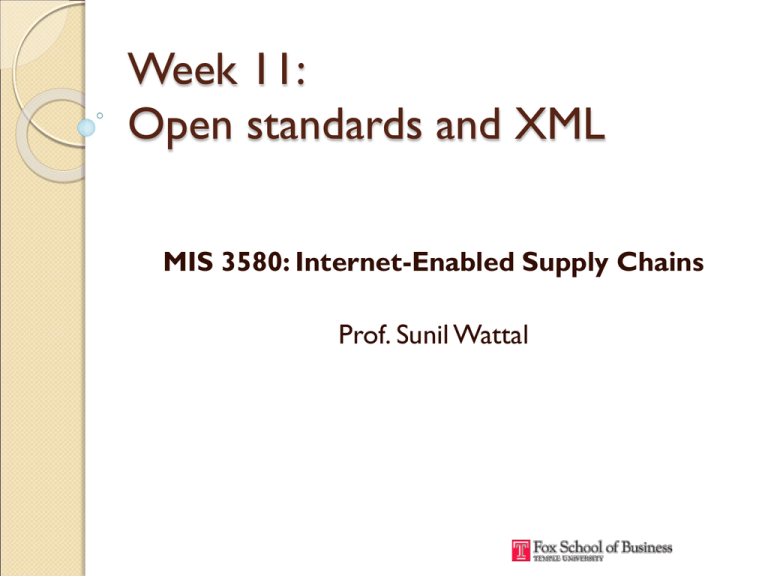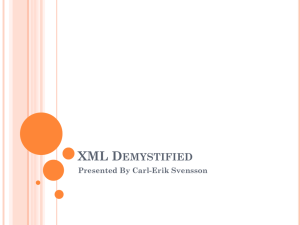Week 1: Introduction
advertisement

Week 11: Open standards and XML MIS 3580: Internet-Enabled Supply Chains Prof. Sunil Wattal Learning Objectives Electronic Data Interchange RosettaNet standards XML and Web services How computers communicate? Computers connected to a network can pass messages to each other Unicast ◦ One sender, one receiver Multicast ◦ One sender, many targeted receivers Broadcast ◦ One sender, everyone else a receiver Getting ‘em to talk Consider our beer supply chain ◦ The retailer uses Windows PCs ◦ The distributor uses Linux workstations ◦ The wholesaler and the factory have old IBM mainframes How do you pass messages among these entities? Protocols Protocols are computer communication standards ◦ HTTP, HTTPS, FTP, SMTP, ATM, NNTP etc Protocols wrap the actual message in a packet, add some extra information (called header) to it and transport the packet across the network At the other end, the receiver gets the packet, knows what the protocol is, and unwraps the packet to get the message EDI Electronic Data Interchange Structured transmission of data between organizations by electronic means Is it like e-mail? No! EDI is like a technical representation of a business conversation between two entities, the entities being two computer systems Components of an EDI system Computer System ◦ A computer, a modem and an Internet connection But EDI is more than just the hardware ◦ ◦ ◦ ◦ Data transmission Message flow Document format Software used to interpret documents Older than the World Wide Web EDI has been in use for a long time Companies connected to their partners using direct connections With the advent of the WWW, noninternet transmission methods are being replaced by Internet protocols EDI standards UN/EDIFACT ◦ Recommended by the UN ◦ Predominantly used outside North America ANSI ASC X12 ◦ Recommended by the US ◦ Predominant in North America TRADACOMS ◦ Used by the UK retail industry ODETTE ◦ Used within the automotive industry in Europe EDI standards (contd.) Standards prescribe ◦ Data formats ◦ Character sets (eg: language, encoding) ◦ Data elements Major drawback ◦ Requires effort to get different standards to interoperate among each other ◦ But there are specific software tools called EDI translators to help overcome this Advantages & disadvantages Advantages ◦ Increased efficiency ◦ Cost savings ◦ Weeds out paper-based systems Disadvantages ◦ Requires changes to business processes ◦ Initial setup cost and time ◦ Forced adoption (eg: Wal-Mart requires all of its partners to have compliant EDI systems) Learning Objectives Electronic Data Interchange RosettaNet standards XML and Web services RosettaNet RosettaNet is a self-funding non-profit organization Founded in 1998 by 40 IT companies; now over 350 member companies Creates, implements and promotes industry-wide ebusiness standards that form a common language and align processes throughout the global high-tech trading network Members include IT, electronic components and semiconductor manufacturing companies RosettaNet standards RosettaNet dictionaries ◦ Provide a common set of properties for business transactions RosettaNet Implementation Framework ◦ Provides common exchange protocols Partner Interface Processes ◦ Define business processes between trading partners The standards in perspective RosettaNet standards enable communication Dictionaries provide words for the communication RNIF provides the grammar PIPs for the dialog RosettaNet partners – Electronic Components Industry Partners – IT Industry Partners – Semiconductor Industry Learning Objectives Electronic Data Interchange RosettaNet standards XML and Web services Markup and tags HTML – Hypertext Markup Language ◦ A way to define how a web browser displays content ◦ Makes use of tags; tags control display ◦ Any content within <b> and </b> will be displayed in bold ◦ The function of each tag is defined; not possible to modify ◦ Tags can be nested; <b><u>content</u></b> ◦ New tags cannot be defined eXtensible Markup Language XML is not HTML; it is not an extension of HTML XML also uses tags; but all XML tags are user-defined XML is not used to control how content is displayed; it defines the content eXample <student> <student-name> <first-name>Jane</first-name> <last-name>Doe</last-name> <year>Junior</year> <major>MIS</major> <major2></major2> <minor>Marketing</minor> </student> Understanding XML In the previous example ◦ A student’s details are presented in XML format ◦ Each XML file has a schema – a file that defines what tags are permitted, and what nesting is permitted in each XML file ◦ Similar XML files share the same schema ◦ When information is transmitted between parties, is the schema is sent along with the content, the receiver can make sense of the content that is being transmitted How does it help? All that two parties need to do is to agree on the schema No special systems needed to decode the incoming data XML is a popular and widely-used standard; everyone is adopting it Web services Web services are business and consumer applications that are delivered over the Internet Users access these services to get the information they need Uses a set of shared protocols and standards, largely based on XML Can be accessed through a variety of systems and devices Why do Web Services matter? Faster, cheaper integration Systems integration is the single biggest IT expense for most companies Web Services obviate the need to create develop interfaces – less work, less worry!





![[#CARBON-13743] Key store password of catalina](http://s3.studylib.net/store/data/007841975_2-b5be293be17dfbfd4fa5374476b625ea-300x300.png)

